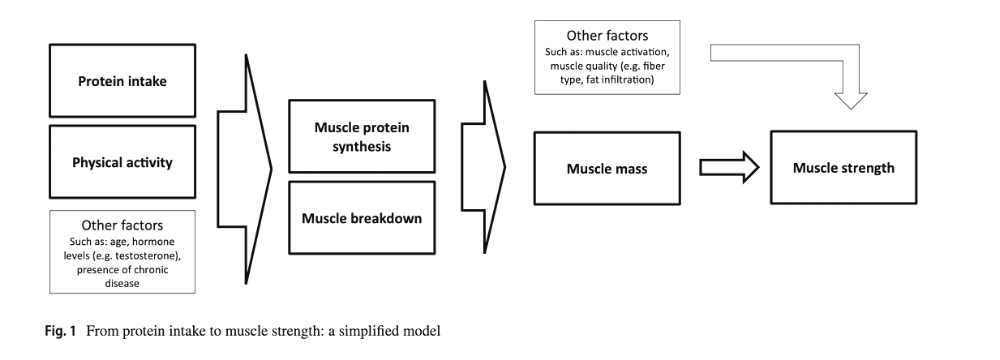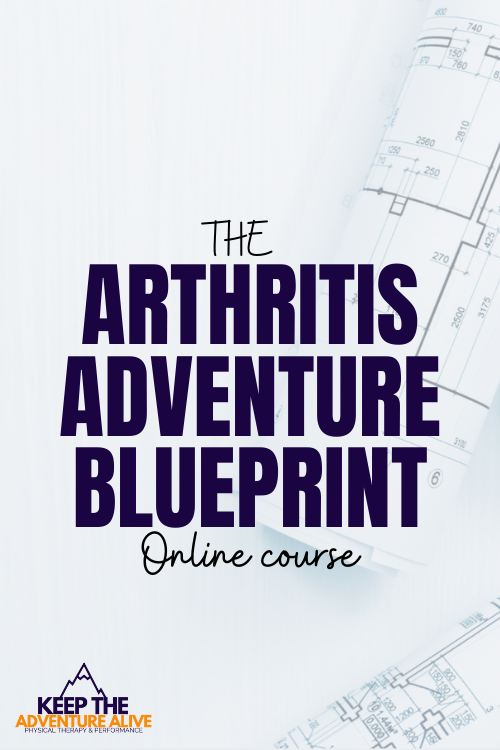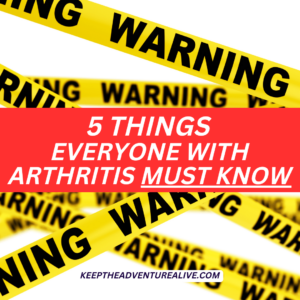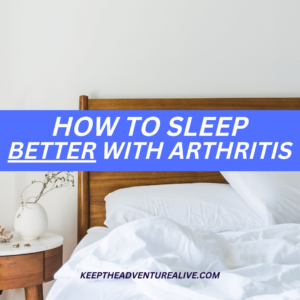We know that protein helps to build stronger muscles but did you know it is also anti-inflammatory? Scientists and nutrition experts have been looking into protein for arthritis and its benefits for years now. Research has shown that inadequate consumption of protein and it’s essential amino acids can actually lead to increased perceived level of pain! There are 3 essential amino acids that play an integral role in reducing inflammation and maintaining lean body mass (aka muscle)- these include endorphin, serotonin, and GABA. The best way to obtain these amino acids is to eat them in high protein foods! Let’s learn more about protein for arthritis below.
This article may contiain affiliate links that provide us with a small commission if products are purchased through these links at no extra cost to you.
“If arthritis symptoms are debilitating and activity is compromised, getting enough protein is essential to holding on to muscle mass and function,” says Douglas Paddon-Jones, PhD, professor of aging and health at The University of Texas Medical Branch in Galveston for an article published by the Arthritis Foundation.
Unfortunately a large number of the world’s population is not getting the right amount of protein. Let’s do some quick math to see if you are. Take your body weight in pounds and multiply it by 0.7. This number is approximately the number of grams of protein you should be consuming per day…
Many times, we think we are getting way more protein than we truly are. Take a look at the protein content of common foods according to Johns Hopkins:
- An egg has 6-8 grams of protein
- Most greek yogurts have 12-18 grams of protein
- A typical chicken breast (4oz) has about 30 grams of protein
- A half cup of cottage cheese has about 14 grams of protein
The idea is, you may not be consuming as much protein as you think you have been. Quite a few of my clients have been shocked, thinking they were consuming an adequate amount of protein then adding up a typical day to find out they are way under the goal.
Let’s dive into WHY you should be eating more protein and the benefits to your arthritis pain!
I promise, increasing your protein intake will not automatically make your biceps bigger or create huge muscles like in those bikini fitness shows. Instead protein can bring healing powers for arthritis pain relief, maintain stronger bones, and reduce inflammation! Learn the 5 reasons you should be eating protein for arthritis below:
1. Protein prevents muscle wasting
Did you know that protein is responsible for maintaining and growing your muscles? Odds are you probably did. But did you know that without the right amount of protein, your muscles are at risk for getting weak, even if you are exercising?!
We hear time and time again that strength training can have amazing effects on arthritis pain. This is because the stronger your muscles are, the more force they are able to absorb, instead of your joint having to do all of the work. If you are strength training but not intaking enough protein, you may not be building muscle like you think you are.
Strength training is meant to cause very small micro tears in your muscles and then with recovery and nutrition, they are supposed to repair to a stronger state. Much of this repair is dependent on protein.
Different researchers have dove into the effects of protein on muscle and one interesting study highlighted the true importance of protein when exercising.
"...a modest increase in dietary protein intake... combined with progressive resistance training [strength training] in a vitamin D-replete state has resulted in a greater increase in total body and regional lean tissue mass, muscle size and strength, and functional performance than with progressive resistance training alone in elderly women"
Perna et al, 2019
With the right amount of protein, you can have bigger and stronger muscles which in turn, can make your joints stronger and more resilient even as you age. Almost every client I see, one of their main objectives is to feel stronger and more confident on their painful joints. This is one of the best ways to find arthritis pain relief.
You can use protein for arthritis pain relief by building and repairing stronger muscles such as in the picture below from a research article by de Zwart et al 2018.

2. Protein can help make endorphins
Endorphins are a chemical in our bodies that help to make us feel good and relieve pain. Our bodies naturally produce endorphins with the right pieces. Protein is able to provide vital components needed to make these endorphins. These vital components are called amino acids. Protein is made up of chains of amino acids, giving our body the right tools to begin creating them.
Without the appropriate amino acids, we aren’t able to make as many!
Just how powerful are endorphins?
“In general, the release of endorphins is understood to be associated with the body’s response to pain and also exercise as associated with “runner’s high.” The pain relief experienced as a result of the release of endorphins has been determined to be greater than that of morphine. Additionally, endorphins have been found to be associated with states of pleasure including such emotions brought upon by laughter, love, sex, and even appetizing food” (Chaudhry 2020)
What do endorphins have to do with arthritis pain?
Typical pain medications work by attaching to certain receptors leading to pain relief by mimicking natural endorphins.
The more endorphins you can naturally produce, the less dependent you may be on pain pills. Making sure your body has the appropriate building blocks when creating this chemical is important for maximum relief!
3. Protein helps with weight loss
Weight loss is an integral part when dealing with osteoarthritis pain. Protein is a very important part of this process as it keeps you fuller for a longer period of time.
Many times, if your meal is primarily from carbohydrates (cereal, breads, pasta, etc) you likely will feel hungry a short time after eating. If, instead, you eat lean meat, cottage cheese, greek yogurt, or even a protein bar- you usually can go longer without feeling like you need to eat again.
This in turn can decrease the number of times you are snacking throughout the day and decreasing caloric intake.
Besides just the intake, as mentioned above, protein helps with lean muscle building and recovery. I heard this quote in a recent podcast episode from the Consistency Project where EC Synkowski went on to explain that “muscle tissue is expensive” meaning it takes a lot of calories to support it. The more muscle tissue you have, the more calories you burn.
If you have too little muscle mass, you may have to eat less calories to lose weight compared to someone with a higher muscle mass because they are using more calories throughout the day.
Starting a strength training routine is your best bet to start building muscle no matter your age! Now, the younger you are, you likely will build muscle a little quicker but it’s never too late to start and you can still reap AMAZING benefits.
What does weight loss and muscle mass have to do with arthritis? The less body fat you have, the less inflammation you will carry. This means your joints will be less irritated! Also the more lean muscle mass you have, the easier weight loss can become. Find out 14 other ways you can reduce inflammation here.
If you would love tips on how to get started with strength training, sign up for the FREE 4 Day Arthritis Friendly Workout Challenge by clicking the button below.
4. Protein can be anti-inflammatory
Most foods that are high in protein, likely are healthier and more quality food sources.
Now, don’t get me wrong, there are still some foods that are high in protein but may not be the most nutritious. For example, some protein bars and greek yogurts have just as as much fat and added sugar as some candy bars!
Find arthritis friendly, high protein snacks in this food guide here.
But for the most part, a homemade protein smoothie, lean meats cooked at home, cottage cheese, beans cooked at home, and other higher protein foods are not as highly processed as foods high in carbohydrates and fats can be.
Many of these processed foods that are high in simple carbohydrates, saturated and trans fats can be inflammatory.
Common culprits can be sugary foods and drinks, low fat, sugar free, and fat free options of foods, and foods that typically come in boxes with a long list of ingredients.
Focusing on protein can help to get more nutrients out of foods.
You can’t lose sight though that just because it has protein in it, does not make it healthy. Natural foods that are typically found on the perimeter of the grocery store is a great place to start.
Take a look at the ingredients. Try to consume at least a protein source at every meal (number of grams will be dependent on how many total grams you need throughout the day).
Protein for arthritis can be extremely powerful to drive down inflammation if you are focusing on the right things primarily including quality of food choices.
If you would like a list of the best anti-inflammatory foods, head to this post.
5. Protein helps you age well
As you get older, some of your body processes become less efficient and the way your body handle protein is one of them. This is coined “anabolic resistance“.
According to an article on InForm: “Anabolic resistance means that the signals to build up muscle through strength training or eating protein is muted in older adults. Luckily, This resistance can be overcome with an increased amount of strength training or a higher intake of protein.”
A higher intake of protein ensures you still build muscle and prevent the loss of muscle mass you have.
If you have osteoarthritis, you are at a higher risk to develop anabolic resistance due to the presence of inflammation and potentially decreased activity levels secondary to joint pain.
Without the right amount of protein and the appropriate resistance training, you will continue to lose muscle mass. This can put you at risk for more arthritis pain and increased difficulty completing simple tasks.
If you are looking for ways to build muscle support for your joints without the worry of injuring yourself, try this free 4 Day Arthritis Friendly Workout Challenge.
This challenge starts out with bodyweight movements and progresses to weight training to help you learn the best ways to build strength. Sign up below to start finding pain relief!
Some of my favorite ways to get protein:
When looking at getting protein, whole foods can be a preferred source. But, I totally understands it’s not always possible.
Here are some of my favorite products when it comes to getting adequate protein with arthritis:
- Orgain Grass Fed Whey Protein Drinks
- Ascent Protein powder
- RISE protein bars
- Vega Vegan protein powder
Learn more about more specific snack choices that are arthritis friendly in this guide.
Conclusion
Protein is extremely important as you get older but has even more importance if you have osteoarthritis. It can help you build muscle, find pain relief, lose weight, and age well! Making sure you get the appropriate amount of protein is vital to your success in keeping your adventure alive with arthritis.

The Arthritis Adventure Blueprint
Dr. Alyssa Kuhn’s signature program to help you go from hopeless to hopeful with osteoarthritis. You will learn the secrets to arthritis pain relief that actually work- including exercise, diet, and other ways to control inflammation! Say goodbye to short term pain relief, it’s time to make it last.
Alyssa Kuhn
Disclaimer: This post is for general informational purposes only. It should not be used to self-diagnose and it is not a substitute for a medical exam, cure, treatment, diagnosis, and prescription or recommendation. It does not create a doctor-patient relationship between Dr. Kuhn and you. You should not make any change in your health regimen or diet before first consulting a physician and obtaining a medical exam, diagnosis, and recommendation. Move Well Age Well, LLC and Dr. Alyssa Kuhn, PT, DPT are not liable or responsible for any advice, course of treatment, diagnosis or any conclusions drawn, services or product you obtain through this video or site.
References:
Chaudhry SR, Gossman W. Biochemistry, Endorphin. [Updated 2020 Aug 11]. In: StatPearls [Internet]. Treasure Island (FL): StatPearls Publishing; 2021 Jan-. Available from: https://www.ncbi.nlm.nih.gov/books/NBK470306/
Dragan S, Șerban MC, Damian G, Buleu F, Valcovici M, Christodorescu R. Dietary Patterns and Interventions to Alleviate Chronic Pain. Nutrients. 2020;12(9):2510. Published 2020 Aug 19. doi:10.3390/nu12092510
de Zwart AH, van der Leeden M, Roorda LD, et al. Dietary protein intake and upper leg muscle strength in subjects with knee osteoarthritis: data from the osteoarthritis initiative. Rheumatol Int. 2019;39(2):277-284. doi:10.1007/s00296-018-4223-x
Perna S, Alalwan TA, Al-Thawadi S, et al. Evidence-Based Role of Nutrients and Antioxidants for Chronic Pain Management in Musculoskeletal Frailty and Sarcopenia in Aging. Geriatrics (Basel). 2020;5(1):16. Published 2020 Mar 6. doi:10.3390/geriatrics5010016




